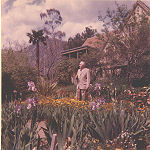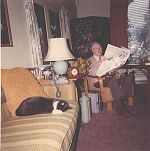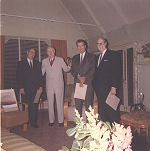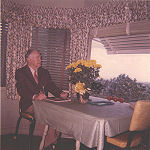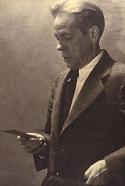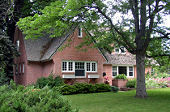|
|
|
Purcell and Elmslie, Architects Firm active :: 1907-1921
Minneapolis, Minnesota :: Chicago,
Illinois |
Ye Older Grindstones
2/6/2005
George Grant Elmslie and his wife, Bonnie Hunter Elmslie
ca. 1912
This picture was taken, I think, on an afternoon office outing to the E. W. Decker summer residence construction site at Lake Minnetonka.
William Gray Purcell, posing with (unlit!) pipe for humor's sake
ca. 1940s
And doing a great Walt Disney impersonation at the same time.
"Westwinds"
1948
Every once in a few decades the weather brings snow to Los Angeles and environs. This particular storm gave Purcell his last encounter with the frozen precipitation that characterized so many winters in so many places over the first five decades of his life. Of course, he made note of exactly that.
Dorothy O'Brien
ca. 1940s
Dorothy came to live at "Westwinds" after a stint with British Intelligence during World War II.Caravanserai. In my ongoing review of the many record cartons of research materials whose contents I have collected or received as gifts over the past twenty-five years, there has recently emerged a curious sense of holism. The stuff I need is already at hand, though my needs seem to have changed. My own journey through the organon nears some level of maturity. My insight has shifted to a broader scope where the same materials are born anew to my mind. Facts and figures, birth and death dates, locations and the elements of circumstances, these were the point of gathering letters, manuscripts, photographs, accounting materials, and all the rest. There was an intellectual motivation at work that has, through the turning of these decades, transformed into something else. As I come across documents both familiar and forgotten, perhaps for the first time since the 1980s, I marvel that what I once knew inside and out through an iteration of details tells me a story completely different. The crystals of individual records are returning to an energetic, flowing state of liquid light. What has changed, of course, is not the documents, but my conscious awareness. This is the way of the Path.
Bill, Cecily, and Dorothy living as much on the lanai as inside at "Westwinds"
November, 1953
Westwinds, facing the lanai
ca. 1950s
Purcell's bedroom is in the wing on the right
The view from the lanai
ca. 1950s
Marie, the "Westwinds" housekeeper and cook for 20 years (1945-1965), with an inevitable Cocker Spaniel
1950Douglas Donaldson, by then a production designer at Metro-Goldwyn-Mayer, would bring up the latest movies on many weekends for private screenings, but what studio fantasy could compare with the idyllic reality of everyday life at "Westwinds"? Purcell spent the last thirty years of his life in a state that his sister-in-law Dorothy O'Brien described to me as "semi-invalid." The risky surgery that removed a portion of his lungs in the mid-1930s was do-or-die. What a cocoon of time that five year stretch in the sanatorium at Banning must surely have been for him. Barely able to walk from an advanced state of tuberculosis, Purcell could only lay in his bed as figures who were among the foremost of his personal journey, grandmother Catherine Gray, father Charles A. Purcell, and adopted son Douglas, died far beyond his arm's reach. His wife Edna demanded a divorce, yet would not settle until the millions of Charles Purcell's estate were released from the trust held at an Oak Park bank--something only Purcell could do even if he was prone on his back.
William Gray Purcell and his second wife, Cecily
ca. 1950s
Cecily was even more "semi-invalid" than Purcell, though she really suffered with a poorly diagnosed case of emphysema. Both she and Purcell's ex-wife Edna died in 1959. Edna had breast cancer, the same as WGP's mother, as she was like her in so many other ways.
William Gray Purcell in his "Westwinds" garden
ca. 1960s
What you can't see in this picture are the pine trees in the back yard, imported by gift as seedlings from Island Lake, and still growing proudly the last time I was on Barhite Street, some twenty years then, now forty-five, after this photograph.
Dorothy O'Brien at "Westwinds"
1958
One hobby shared by all was the nightly feeding of raccoons native to the hillside. Generations of mothers brought their pups for the free dinner. Of course, the Cocker Spaniels had to be locked in the house.
Dorothy O'Brien and Cocker Bother at the "Westwinds" gold fish pool
ca. 1950s
The little Japanese bridge wound up eventually on the grounds of David Gebhard's house in the Montecito highlands above Santa Barbara. The pool which remained at my visit to "Westwinds" in 1981 looked quite forlorn without it.The Great Depression raged across America, and Purcell received letters from desperate friends, like the wife of Carl K. Bennett, beseeching his support, both personal and financial. The surgery was more than a medical necessity for Purcell, it was a final crucible on the Path through which he had to pass with complete surrender. His gamble on the surgeon's knife in an era where a stray infection could easily kill if the operation itself wasn't botched proved a happier outcome than had been the case with George Elmslie's cherished wife Bonnie in the 1910s. In less than a year afterwards Purcell arrived at the oasis of "Westwinds," the southern California estate where he would live to tell the organic story from every possible perspective for the following three decades.
William Gray Purcell in his "Westwinds" living room,
with unconcerned cat Boots
ca. 1960s
Compare with photograph taken by Purcell in the late 1890s of his grandfather, William Cunningham Gray. It was in the genes. For a better, and later view of the Chinese screen behind him, see below.
William Cunningham Gray
1901
WGP took this image on a winter day while home from college at Cornell, just after his grandfather was diagnosed with cancer. Dr. Gray lived to three score and eleven. Purcell managed four score and five. Yet, there is a quality about these two images that speaks of the same moment in life.
William Gray Purcell receiving his AIA Fellowship award
ca. 1960s
The AIA required two years and two committees to find Purcell worthy, but his friend James Van Evera Baily prevailed. Says a lot about their treatment of the organic pioneers in general. At least Purcell was still living, where as Sullivan and Elmslie were not when theirs came around.
William Gray Purcell at his "Westwinds" kitchen table
1965
This was the last picture taken of Purcell by Dorothy O'Brien, as he surveyed from the hilltop a world he was soon to leave. The beloved dogs, cats, and even the budgie went on ahead. Still, there are fresh flowers.Earlier Grinds have mentioned the Banning period with similar detail. However, my recent experiences, while not remotely as dramatic or physically debilitating as Purcell's, have brought me to what is perhaps a confluent state of mind. I question that I have another twenty-five or thirty years, either, to get through the task; all of which makes my present motions somewhat poignant. Certainly, though, the last six years have felt like my personal equivalent to Banning in some ways, and at just about the same age as Purcell, I speculate if I am arriving at my own oasis on the Path, also in southern California all of thirty miles from "Westwinds." I wonder if I get the garden, as well. Our mutual calendar time here overlapped only a few months before his death in 1965, and of course I would know nothing of him or the circumstance until I drifted, or more accurately careened, to Minnesota some twelve years later.
Dorothy O'Brien
1981
The Chinese screen from "Westwinds"
Dr. Gray's Desk, or at least the remaining half of it, upon which many a Musing was written. I had the great privilege to visit with Dorothy several times in her retirement community not all that far from "Westwinds." She was a great lady, and so was her partner Mary Ross, who kindly inscribed the author's copy of Purcell's St. Croix Trail Country that I received as a gift since Dorothy suffered from macular generation. She also gave me the Nejavitz painting and almost all the photographs in this Grind, plus numerous other documents I am still discovering in her many envelopes and boxes mailed to me over the years before her death. None of this musing is meant to be self-indulgent. There is a curious dj-vu to things lately that brings these events to mind. I am still sorting it all out, and perhaps some conclusive understanding will emerge from touching the final piece of paper in the very last of these boxes that have somehow survived alongside me amid the repeated upheavals of uncounted shifts of residence. Maybe I have to get to the ending period of the sentence that terminates The Book. The sensation in between is much like being in two places at one time. Or is it two times at one place? That paradox is the nature of the Path, and as Purcell said in his own poetic rendering, those on the Path take the same Caravan. Turns out one of the fundamental principles of quantum physics explains the uncertainty quite well: the more you know where you are, the less you know how you are going, and vice versa. Notice there is no direct mention of where you have been, only, as David Bohm turned the phrase, the wholeness of implicate order. And so, we are back to the subject of organic architecture.
The first machine, an Aptiva Pentium I 100, to serve the pages that became known as Organica. It's an iron horse, still working, with 16-bit everything that cannot cope with much of the modern world (1994-1996).
The second Organica server, an AST Pentium I 200, which really was a work horse that always ran Windows NT 4.0 and stepped right up to Active Server Pages for HyperFind when that software first appeared (1996-2004).
The third Organica server, a Compaq Presario 5170 [die, die die, stupid BIOS on hard drive partition!] lasting all of six weeks (2004-2005); shown disgorged of the CD-W drive and the ZIP drive, transplanted without much color coordination into its successor, at right..
The latest Organica server, another HP Compaq, not that I wanted another one, but it was what I could afford (2005- ). Thanks to Deborah Van Deusen at TechDepot, a great service rep who stays in regular touch.I am still recovering from the demise last weekend of three [!!!] computers (old [1998], older [1994], and oldest[1992]) in the same week, all of which served these pages or their forebears for lo these many years. In this way, perhaps, I have always served myself. Organica has always been a storefront on the web from one of these four computers, which sat at my feet. Looks like I get one day a week[end] to gnash away at this site, so Grindstones are most likely to come on the weekend for those regular readers who, missing their frequency, have kindly inquired of my wellbeing. Thanks to all in the Caravan, whenever you are.
1/29/2005
Street facade
John Storer residence
Frank Lloyd Wright
Hollywood, California 1923
Street facade
Samuel Freeman residence
Frank Lloyd Wright
Hollywood, California 1924
Living room
Charles W. Ennis residence
Frank Lloyd Wright
Hollywood, California 1924
Dining room
Charles W. Ennis residence
Frank Lloyd Wright
Hollywood, California 1924
Intermediate Period. Once in a while over the course of the past four years, my otherwise regular attention to development of this web site has been drawn unwillingly distant from the keyboard. The Grinds have proven their personal use to me in showing how I was distracted hither and yon with the tremors and track-shifting that constitutes what we call the passage of life. Indeed, experience to date has verified the truth of the old saying, if I may paraphrase, that "life is what happens while you would rather be making web pages." My recent downtime started with the death of both my cats across a month of the Fall (so aptly named), and dealing with other troublesome issues like root canals, tumors sprouting at various bodily places (benign but startling), and automobile meltdown. We won't even get into the stress level at the work which pays for the existence of this site. For about five months, my life seemed to be a reenactment of, say, Herculaneum, ca. 79 CE; an imperfect metaphor, however, because I don't know my years have ever enjoyed anything approaching the sensuous relaxation of a Roman seaside resort town.
Hallway
Charles W. Ennis residence
Frank Lloyd Wright
Hollywood, California 1924
Fireplace over-mantle mosaic
Charles W. Ennis residence
Frank Lloyd Wright
Hollywood, California 1924
Douglas Donaldson
circa 1920s
Announcement for color theory class
Douglas Donaldson
ca. 1920sThere were some fortunate moments toward the end. Recently a delightful and intelligent woman who was an Apprentice during my time at Taliesin visited Los Angeles with a second sojourn to my hospitality. We undertook the obligatory tour of Frank Lloyd Wright edifices, specifically the textile block houses, which we had earlier missed due to time constraints. Her timing this visit was excellent for attending a small sunset wine and cheese get-together at the Ennis-Brown house permitted as a personal favor to me by a lovely, generous, and dynamically concerned member of the board of the Trust for the Preservation of Cultural Heritage. Thus, we knocked off three of the four textile block houses in one afternoon, missing only the smallest one, La Miniatura (Millard house), which is in Pasadena. All but Millard rest in the Hollywood Hills, Storer and Freeman being the others. Since Purcell was in and out of Hollywood at the time these were under construction, I wonder if he saw them as they climbed upward from their hillside sites one 16" square block at a time (see WGP's Hollywood Cafeteria report, in truth only an excuse to spend time in California with his friend from the Minneapolis Handicraft Guild and now color consultant to the movies, Douglas Donaldson, of whose 1940s handiwork I possess a characteristic painting frame).
Hallway rug
George Grant Elmslie, designer
Henry B. Babson residence
Riverside, Illinois 1910
Decoration for a Hall
Gesellius, Lindgren and Saarinen
Helsingfors, Sweden Originally appeared in Moderne Bauformen, Julius Hoffman Verlag, Stuttgart, Germany. Catalog of the Fourth Exhibition, Pittsburgh Architectural Club (1907), unnumbered plate.Earlier in the day we went to see the delightfully installed Arts-and-Crafts show, The Arts & Crafts Movement in Europe and America, now at the Los Angeles County Museum of Art [LACMA, under Exhibitions] and curated by Wendy Kaplan. There was just one P&E piece, a hallway rug from the Henry B. Babson house. In the synchronistic way I have known to be the organic world, Wendy happened to be there leading a group from the Friends of the [Greene and Greene] Gamble House, which has recently been exquisitely restored. (The contractor for the Gamble work was Voss Construction, which one in earnest hopes will have the time this year in their rapidly filling 2005 schedule to take on the much needed 1994 earthquake repairs of Ennis-Brown.) I walked up and said hello. Wendy recalled my contacts with her during an earlier Arts-and-Crafts show in the 1980s she curated at the Boston Museum of Fine Arts, and charmingly autographed my copy of the show catalog with "sincere regret for the paucity of P&E in the show." However, she has nothing else to regret, since she has managed to include progressives from 14 countries, from Scandinavia to Austria, England to Germany, Scotland and America, and most every place in between showing the widest possible range of media and materials even if she was limited by space to one or two pieces for each designer. In one of those treats that can come only so often in life, the original rendering for Saarinen's "Decoration for a Hall," a drawing that I had known for twenty years only from a 1907 color lithograph, hung in situ on the gallery wall. The show runs through April 3, 2005, and alone is worth the airfare to Los Angeles for anyone likely to be reading this Grind.
Timecard [#2] for William Gray Purcell
Feburary 10-16, 1913
Timecard for George Feick, Jr.
May 23-29, 1910
Timecard for George Grant Elmslie
May 11-17, 1914The month of December was spent largely on directing research at a distance for The Book. The Northwest Architectural Archives was kind enough to allow my hired hand (research assistant) in Minnesota, Anya Klaassen, not only to mark beaucoups items for photocopy, but also hauled up all of the thousands of sheets of P&E working drawings. Anya inventoried the names and dates of those Team members who signed them. Together with the remaining P&E office timecards, which are incomplete because Purcell later used many for 3x5 note cards, this original research enables a time line of who was in the office when, and what they worked on. Many thanks to the excellent ministrations of Anya. Bruce Brooks Pfeiffer and Oskar Muoz are providing copies of many P&E letters from the Bill Marlin collection at the FLLW Archives, which are mostly concerned with Alphonso Ianelli's dire straits in meeting the terms of his contract for sculpture groups at the Woodbury County Court House (Marlin was the FLLW biographer authorized by the Foundation, but he died prematurely and his research materials remain a wondrous resource in boxes at the Archives).
Source: www.ci.fort-collins.co.us
Marion Alice Parker-Frank P. Stover House
Marion Alice Parker, architect
Fort Collins, Colorado 1920s?
Clayton F. Summy residence
George Grant Elmslie, architect
Hinsdale, Illinois 1924
Hmmm. Just a thought.
E. A. Tyler Hardware Store
Haugen and Newstrom, architects
Minneapolis, Minnesota 1915
Illustration plate
The Fourth Dimension
Charles Hinton 1906A happy discovery also related to the P&E Team was forwarded to me by Barb Bezat, assistant curator of the Northwest Architectural Archives and my early trainer in the demand for precision in descriptive prose. Seems that Marion Alice Parker had a Colorado sojourn on her eventual way from Minneapolis to Laguna Beach, California. An exemplarily useful web site provided by Fort Collins shows the existence of a house designed by her for a drugstore proprietor who once ran afoul of the law for selling alcohol in his pharmacy (cocaine and opiates were legal, widely, and wildly popular legal stock in trade, though the Harrison Tax Act of 1914 was working as intended to prevent those poor, unruly Hispanics and African-Americans from easing their harsh manual labor discomforts with marijuana and thus be prone to violent attacks on white people. I don't make this stuff up, but did you get any of this racist history in high school?). Another bit of Team work, so to speak, surfaced via photograph in The Western Architect of a small store by a firm in which P&E drafter Paul Haugen was later a partner architect. Note the inevitable presence of the tesseract motif, both on the facade and the delineation of the skylight on the plan. I need to check if Haugen worked on the Madison Bank. Speaking of tesseracts, more pieces of the overall puzzle came to hand with the short term loan of a rare 1906 edition of The Fourth Dimension, a work by Charles Hinton illustrated with some very telling color plates. A recent informal discussion with another extremely bright member of the Trust board that runs the Ennis-Brown house let me in on just how fine and delicate a path I must tread to sort out these things out.
<-- Front elevation William Gray Purcell residence
aka "Georgian Place"
Purcell and Elmslie
Portland, Oregon 1920Nils the Gooseboy -->
Richard Bock, sculptor
This is the third one of these forms made by Bock. One was destroyed in a 1920s train wreck, and the other is on loan to the Minneapolis Institute of Art from the Bock collection at Greenville College and rests on a ledge in Lake Place.
As has been the way with this site, recently I had the pleasure of an email from the present owner of the residence Purcell built for his family in Portland, Oregon, known as Georgian Place. There is a tale about Purcell's comments concerning interior redecorations done in the 1950s or so by the then owner who is still living. He sent his personal secretary, Melva Guibert Rodgers, up and around the country to see his work, since she was typing all those manuscripts that poured from his pen (and Soundscriber) during these years of biographical rumination. Melva reported the changes to Purcell, who lamented the results as a desecration. His comments somehow got back to the insulted owner. This story passed down to the newest owner who, with careful paint analysis, is intent on restoring the former detailing as much as it turns out to be viable. He reports that the statue of Nils the Gooseboy still soars out from a fireplace mantle niche, and has promised photographs to Organica to which we can all look forward. I'm thinking before and after...
Free plug for a good book
Transportation Building (painted red, not white)
Adler & Sullivan, architects
World's Columbian Exposition 1893
This view from the Wooded Isle, which Olmsted struggled to keep clean of buildings, but where Burham placed the Japanese pavilion of such keen pleasure to Frank Lloyd Wright
The Golden Door (also not white)
Construction of the Golden DoorThanks to my neighbor Maureen who gifted me, I recently completed reading The Devil In The White City, by Erik Larson, subtitled Murder, Magic and Madness at the Fair That Changed America. The narrative dwells in the dichotomy of struggle and eventual triumph that was the development and run of the World's Columbian Exposition of 1893, and the (then) inconceivable predations of one Herman Webster Mudgett alias, among many, D. D. Holmes, who holds the historical position of being the first recognized serial killer in America. The Jeffrey Dahmer of his time, Mudgett preyed on the many young women who came to Chicago during the time of the Fair seeking social and possible romantic freedoms theretofore unknown to single females, as well as sundry men and children along the way. Mudgett possessed a mesmeric ability to entrain followers, male and female alike, to supply him with material and psychological advantages that he then turned to murder, often their own. Contrasted to the sacrifice and burden shouldered by people like Daniel Burnham and Frederick Law Olmsted to produce a tangible expression of the wealth, pride, and pretension that was 1890s Chicago, the drama of death by extreme evil unfolds in a real page turner that everyone interested in this period of history should enjoy--although Louis Sullivan gets only passing mention, while the Transportation Building gets but little more.
The Los Angeles River--my backyard, so to speak--in freshet for about two weeks running.
Shadow, a charmer, redeemed from the spurning of superstitious idiots who discard black cats into the dumpster.
Isis, half-Siamese and half-tabby, who looks very much like an ocelot with bright blue eyes.
Griffindor, half Maine Coon, in honor of the departed Precious; guess I don't want to be without one of the breed.Finally, there are two adjustments to my immediate environment that deserve mention. During the recent period of heavy rains, I had occasion to observe in myself a desultory pattern of coming home from work only to crash in front of the television. (Get this: My doctor actually said to me, and I quote: "You're over fifty now, Mark. Face it. At your age, when you get off work for the day you are finished!" Uh-huh.) My acquisition of cable, while nice for HBO's extraordinary Deadwood and the various archaeological shows on the History or Discovery Channels, was sucking down time better spent on other callings. So out, out, damned cable, and along with it the distraction of television. Also, a writer without cats is like a computer without a word processing program. Several regular readers of this site sent condolences on the deaths of Special and Precious (recounted earlier in the Grinds), which I appreciated greatly. I have adopted three more felines, all from rescue organizations, who joyously returned a sense of animal aliveness to my home. With these changes in place, I notice a great deal more productivity and attention to the workings of my office. Perhaps this somewhat flush Grind is a testament to such improvement.










